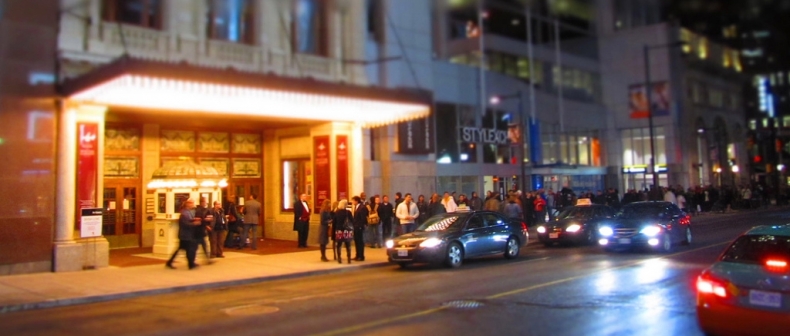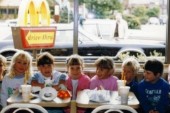
Image via Flickr user canmark
Last weekend, Toronto stopped tweeting about brunch, and instead hit the streets for Doors Open T.O. You saw crowds of white t-shirts along Queen Street, gazing up at the brickwork on street corners. I like it when that happens – because above the store signs or the condo showroom ads, this city usually has some 19th century sass worth noticing.
When you think of Queen and Yonge you probably picture the Eaton Centre, the Bay, and the seemingly impossible number of Starbucks franchises within a 50-metre radius. But the intersection is home to some of the oldest parts of Toronto’s early cultural scene, dotted as it is with buildings that were left abandoned for decades, and only recently restored.
Take the Winter Garden Theatre on Yonge, just north of Queen. It opened on top of the Elgin Theatre (then called Leow’s Yonge Street Theatre) in 1914 as a vaudeville hotspot. In its heyday, it hosted the likes of early Fred Astaire and Bing Crosby – but by 1928, when the newfangled motion pictures killed the vaudeville star, the Winter Garden Theatre closed its doors, while the Elgin downstairs re-opened as a cinema (which would end up playing bad horror movies and porn until it reclaimed its theatrical purpose).
But it wasn’t until 1985 that restoration plans for the abandoned Winter Garden began. After accumulating nearly 60 years’ worth of dust, the toughest part was restoring the garden-themed murals that lined every wall in the theatre. But restore them they did, and they updated the theatre to what it is today. Sadly, vaudeville isn’t its jam anymore; but the same structure became the home of different content.
Believe it or not, memory kind of works the same way too. We’re constantly re-updating our memories, and changing what they mean and even what they’re made of. Remember your tenth birthday party? You probably do, but it probably happened very differently from how you remember.
Memories are malleable. In humans, they involve reliving the complete sensory experience of a past event – which led Toronto researcher Endel Tulving to think of memory as “mental time travel.” The thing is, every time you retrieve a memory, you’re actually slightly changing it. The act of reliving past moments actually introduces new elements into the memory, sometimes overwriting the original.
It works like this: when a memory trace gets stored in your brain, it becomes “consolidated.” Essentially, the memory gets solidified in your long-term memory so that it stays put and doesn’t change. But when you recall the memory and relive it, that once-solid memory trace enters a new, flexible state. In that state, you can introduce new information or emotions into the memory. That way the original memory gets updated and re-solidified with the new elements incorporated into it.
Some of the most recent buzz in the memory world has centred around this idea, which scientists call “reconsolidation.” After all, if we can get at the brain’s ability to physically alter a memory trace, perhaps we can control the very process of making memories. Maybe we can even manipulate them.
Experiments in rats and humans have already shown that it’s possible. If you give someone a drug that interferes with the reconsolidation process (during which your brain is essentially making some proteins), you can make the memory much weaker. And in people with traumatic memories, that can be a good thing.
In one study, a group of participants with fear memories were given drugs called beta-blockers, right before retrieving their fear memories. The researchers found that the beta-blockers interfered with the emotional parts of the memory. That is, when the participants put the memory back in storage (i.e. they reconsolidated it), the fear elements weren’t stored with it. It was the same memory, but emotionally dulled.
Researchers say the same could happen for any memory, whether it’s a painful or a pleasant one. If you block the brain from fully reconsolidating a memory – emotions and all – you’ll lose important pieces.
Indeed, reconsolidation is so exciting to memory scientists (and, uh, nerds) because it means we have a road into the way memories are made. By manipulating that process, you can also manipulate the way you remember things – and even if you remember them at all.
The way we experience our cities has a lot to do with memory. We remember the way the Junction was before its gentrification boom a few years ago – and we can still compare every new independent coffee shop to the convenience store it was before that. But in time, we might forget that the neighbourhood was ever different from the way it is right now. Just like we’ve forgotten that people once took their horse-drawn carriages to visit the Simpsons Department Store at Yonge and Queen (now The Bay). The memories get updated and overwritten; just like your tenth birthday party, nothing is safe.
The moral to that story is that memory isn’t as reliable as we think it is. And yes, it’s times like these that you realize your Facebook timeline will one day come in handy.
____
Erene Stergiopoulos writes for Toronto Standard. Follow her on Twitter @fullerenes.
For more, follow us on Twitter at @torontostandard and subscribe to our Newsletter.














